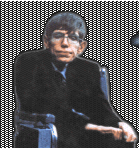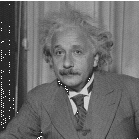
R/1 Science Awards
The Region One Sciences Division Awards will be given annually to Region One members of Starfleet: The International Star Trek Fan Association, Inc., and others, in recognition of their real and Star-Trek contributions to science.
Criteria for Award Certification Are:
- Must be either a dues-paying member of a local chapter or of the international organization of Starfleet
- Must have made the necessary contribution to qualify for the award
- Must be nominated for the award
The Awards:
There are three Region One Sciences Awards: The Steven R. Hawking Award for Original Article, The Albert Einstein Award for Regular Article Submission, and The Galileo Award for Chief Science Officer of the Year. These awards are described below.
The Steven R. Hawking Award for Original Article
 This award is presented annually
to the Starfleet member who makes the most original submission to the Region One Sciences newsletter or to the Science Lab listserver. Nominees may be ANY Starfleet member, and the award
recipient is chosen from among the applicants by a general vote of participating Chief Science Officers from Region One (candidates may include CSO's). The award includes a certificate signed by the R/1 RDC of Science and the Regional Coordinator.
This award is presented annually
to the Starfleet member who makes the most original submission to the Region One Sciences newsletter or to the Science Lab listserver. Nominees may be ANY Starfleet member, and the award
recipient is chosen from among the applicants by a general vote of participating Chief Science Officers from Region One (candidates may include CSO's). The award includes a certificate signed by the R/1 RDC of Science and the Regional Coordinator.
The Albert Einstein Award for Regular Article Submission
 This award is presented annually
to the Regional Chief Science Officer who makes the most regular submissions to the monthly reports to the RDC and the quarterly reports in the Region One Sciences newsletter. This award may be received by more than one CSO based upon the number of article submissions published in Region One Sciences (that is, received by the RDC-Sciences). The award includes a certificate signed by the R/1 RDC of Science and the Regional Coordinator.
This award is presented annually
to the Regional Chief Science Officer who makes the most regular submissions to the monthly reports to the RDC and the quarterly reports in the Region One Sciences newsletter. This award may be received by more than one CSO based upon the number of article submissions published in Region One Sciences (that is, received by the RDC-Sciences). The award includes a certificate signed by the R/1 RDC of Science and the Regional Coordinator.
The Galileo Award for Chief Science Officer of the Year
 This award is presented to the
nominee who is voted by the CSO's of Region One as either the most enthusiastic, most energetic, or most productive member of Region One Sciences. Nominees must be a CSO or other science enthusiast in Region One. The award includes a certificate signed by the R/1 RDC of Science and
the Regional Coordinator, and in addition will include a year's subscription to a journal of scientific importance (such as Omni or Popular Science or Scientific American or Science News).
This award is presented to the
nominee who is voted by the CSO's of Region One as either the most enthusiastic, most energetic, or most productive member of Region One Sciences. Nominees must be a CSO or other science enthusiast in Region One. The award includes a certificate signed by the R/1 RDC of Science and
the Regional Coordinator, and in addition will include a year's subscription to a journal of scientific importance (such as Omni or Popular Science or Scientific American or Science News).
Awards are presented annually at the Region One Summit by either the RDC or ARDC Sciences.
Nominating Procedure:
There is a nominating round, followed by a voting round during which the winner is selected from among the nominated candidates.
Nominations must be sent to the RDC (Richard Heim) no later than eight weeks before the Region One Summit. Voting will take place after that date. The winners will be announced at the Region One Summit.
Nominations should be submitted as follows:
The Hawking Award: nominations must be made by any dues-paying member of Starfleet: The International Star Trek Fan Association (local chapter members may submit nominations as well).
The Einstein Award: the recipient(s) are chosen by the RDC and ARDC Sciences based upon the number of report submissions.
The Galileo Award: nominations must come from a CSO of a participating R/1 ship.
Annual Winners:
The winners of the 2022-2024 Region One Sciences Awards were announced in the January 2025 Region One Sciences report.
The winners of the 2018-2021 Region One Sciences Awards were announced in the January 2022 Region One Sciences report.
The winners of the 2016-2017 Region One Sciences Awards were announced in the June 2018 Region One Sciences report.
The winners of the 2015 Region One Sciences Awards were announced in the June 2016 Region One Sciences report.
The winners of the 2014 Region One Sciences Awards were announced in the August 2015 Region One Sciences report.
The winners of the 2013 Region One Sciences Awards were announced in the June 2014 Region One Sciences report.
The winners of the 2012 Region One Sciences Awards were announced in the May 2013 Region One Sciences report.
The winners of the 2011 Region One Sciences Awards were announced in the June 2012 Region One Sciences report.
The winners of the 2010 Region One Sciences Awards were announced in the June 2011 Region One Sciences report.
The winners of the 2009 Region One Sciences Awards were announced in the May 2010 Region One Sciences report.
The winners of the 2008 Region One Sciences Awards were announced in the June 2009 Region One Sciences report.
The winners of the 2007 Region One Sciences Awards were announced in the May 2008 Region One Sciences report.
The winners of the 2006 Region One Sciences Awards were announced in the May 2007 Region One Sciences report.
The winners of the 2005 Region One Sciences awards were announced at the 2006 Region One Summit in Akron, Ohio. This year we had winners for all 3 awards.
- 2005 Region One Sciences Einstein Award
- Reporting frequency included every month:
- Capt. Dennis Relyea, USS Alaric
- Capt. Debbie Artrip, USS Appomattox
- FCapt. Janice Graham, USS Renegade
- Reporting frequency included every quarter:
- CPO Karolyn Wojtowicz, USS Tycho
- Lt.Cmdr. Cyndi jo Ashby, USS Wasp
- Honorable mentions go to the following CSO's or other officers who reported to me during 2005 but did not qualify (that year) for the award:
- Lt. Lea Relyea (Chief, Fortean Research Dept.), USS Alaric
- Adm. Willy Smith, USS Heimdal
- Capt. James "Jamie" Delantonas, USS Hornet
- PO Denise Clark, USS Jurassic
- Reporting frequency included every month:
- 2005 Region One Sciences Hawking Award
- Lt.Cmdr. Cyndi jo Ashby, USS Wasp
- 2005 Region One Sciences Galileo Award for Chief Science Officer of the Year
- There were 4 nominees for the Galileo Award for Chief Science Officer of the Year (Adm. Willy Smith, USS Heimdal; Capt. Jeff Davis, USS Indiana; FCapt. Janice Graham, USS Renegade; CPO Karolyn Wojtowicz, USS Tycho). The winner of this year's Galileo Award is:
- FCapt. Janice Graham, USS Renegade
- Please join me in congratulating these fine officers!
The winners of the 2004 Region One Sciences Einstein Award were announced at the 2005 Region One Summit. Please join me in congratulating these fine officers:
- Reporting frequency included every month:
- Debbie Airtrip, USS Appomattox
- PO Denise Clark, USS Jurassic
- Capt. Janice Graham, USS Renegade
- Lt.Cmdr. Cyndi jo Ashby, USS Wasp
- Comm. Richard Heim, USS Alaric (not counted per above)
- Reporting frequency included every quarter:
- VAdm. Willy Smith, USS Heimdal
- Col. Dennis Relyea, USS Reprisal
- Honorable mentions go to the following CSO's or other officers who reported to me during 2004 but did not qualify (that year) for the award:
- (XO) Margaret Grunwell, USS Appomattox
- Cmdr. Denise Wolff, USS Charleston
- Lt.Cmdr. Rita Comperatore-Lewis, USS Dominator
- Tina Davis, USS Hell's Fury
- Capt. James "Jamie" Delantonas, USS Hornet
- Capt. Walter Ewing, USS Indiana
- Lt.Cmdr. Patty Heany, USS Pathfinder
- RAdm. Karen Goldbach, Shuttle Pride of Scotland
- Lt. Lea Drawdy (Chief of Geology and Planetary Science), USS Reprisal
- CPO Karolyn Wojtowicz, USS Tycho
The winners of the 2003 Region One Sciences Einstein Award were announced at the 2004 Region One Summit. Please join me in congratulating these fine officers:
- Reporting frequency included every quarter:
- Debbie Airtrip, USS Appomattox
- Capt. James "Jamie" Delantonas, USS Hornet
- PO Denise Clark, USS Jurassic
- Col. Dennis Relyea, USS Reprisal
- Lt.Cmdr. Cyndi jo Ashby, USS Wasp
- Comm. Richard Heim, USS Alaric (but the Alaric's reports don't count, because the Alaric CSO [me] is also the R/1 RDC Science [me])
- Honorable mentions go to the following CSO's who reported to me during 2003 but did not qualify (that year) for the award:
- Chris Johanson, USS Appomattox
- VAdm. Willy Smith, USS Heimdal
- Lt.jg. Patty Heany, USS Pathfinder
- Capt. Janice Graham, USS Renegade
The winners of the 2002 Region One Sciences Awards were announced at the 2003 Region One Summit and in the Region One Sciences report in the September 2003 issue of Scientifica Galactica, the Starfleet Sciences newsletter.
The winners of the 2001 Region One Sciences Awards were announced at the 2002 Region One Summit and in the Region One Sciences report in the May 2002 issue of the Carolina Communicator newsletter.
The winners of the 2000 Region One Sciences Awards were announced at the 2001 Region One Summit and in the Region One Sciences report in the July 2001 issue of the Carolina Communicator newsletter.
The winners of the 1999 Region One Sciences Awards were announced at the 2000 Region One Summit and in the June/September 2000 issue of the Region One Sciences newsletter.
Click Here to Return to Table of Contents
Star Trek Science Trivia Quiz
This trivia quiz was presented at the 2005 Region One Summit Sciences RDC Panel by Region One Sciences. All answers are taken from The Star Trek Encyclopedia (except the first question). The 19 questions and their answers are being posted to the Starfleet Sciences Science-Lab listserver during the summer of 2005, generally on a weekly basis. The questions and their answers will be posted to this web page after they are distributed on the Science-Lab list.Question # 1. In the Star Trek: Enterprise episode, "In A Mirror, Darkly", the Tholians created an interphasic rift into a parallel universe how? (Answer)
Question # 2. What was the name of the scientist who invented the duotronic systems used aboard Constitution class starships? (Answer)
Question # 3. In Star Trek 3: The Search for Spock, what was the name of the Federation science vessel that studied the Genesis Planet? (Answer)
Question # 4. In the NG episode, Descent Part 1, Data was playing a holodeck poker game with which three scientists? (Answer)
Question # 5. In which NG episode did Worf shift between several quantum realities after being exposed to a quantum fissure? (Answer)
Question # 6. In the NG episode, The Pegasus, what experimental device did the ship test, in violation of the Treaty of Algeron? (be specific, be very specific!) (Answer)
Question # 7. What is the name of the (Star Trek universe) scientist who invented the positronic brain? (Answer)
Question # 8. In the VOYAGER episode, Parallax, the USS Voyager is contacted by what they think is a ship trapped where? (Answer)
Question # 9. In the NG episode, Gambit, Captain Picard used terikon particle decay in his research. What is terikon particle decay and what is it used for? (Answer)
Question # 10. In the STC episode, Journey to Babel, we learned that Sarek was disappointed that Spock chose to join Starfleet instead of studying where? (Answer)
Question # 11. In the STC episode, Paradise Syndrome, how was Miramanee's planet threatened? (Answer)
Question # 12. In the VOYAGER episode, Eye of the Needle, the pilot of the ship Talvath communicated through a micro-wormhole with the USS Voyager. Exactly what kind of ship, and whose, was the Talvath? (Answer)
Question # 13. In the NG episode, Where No One Has Gone Before, what did Kosinski come aboard the Enterprise to do? (Answer)
Question # 14. In the NG episode, The Neutral Zone, Science Station Delta Zero Five was a facility located near the Romulan Neutral Zone. What happened to it (give a nice vivid description!)? (Answer)
Question # 15. In the STC episode, The Doomsday Machine, what kind of weapon did the planet killer use to destroy planets, what was it made of? (Answer)
Question # 16. In the movie, ST6: The Undiscovered Country, the USS Excelsior was damaged when the Klingon moon Praxis exploded and affected spacetime. What phenomenon damaged the Excelsior? (Answer)
Question # 17. In the VOYAGER episode, Future's End, what was Chronowerx? (Answer)
Question # 18. In the NG episode, The Chase, archaeologist Richard Galen conducted research to learn about the first humanoid species to inhabit the galaxy. In what stellar group did he conduct his research? (Answer)
Question # 19. In the NG episode, Genesis, after being exposed to Barclay's Protomorphosis Syndrome, Cmdr. Riker devolved into a what? (I'm looking for a specific scientific term.)? (Answer)
Click Here to Return to Table of Contents